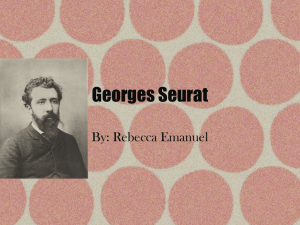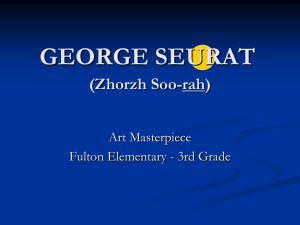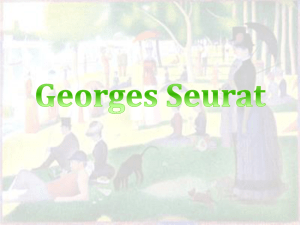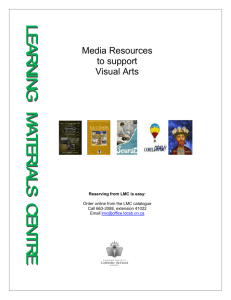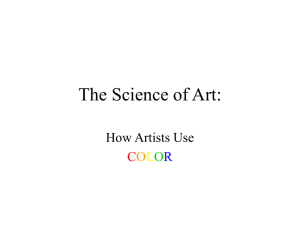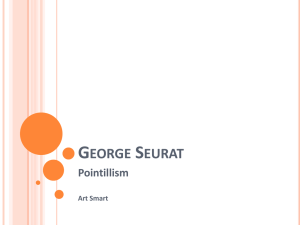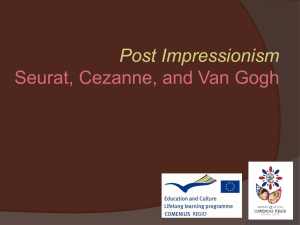A Whirl of Colors: Woman with a Monkey
advertisement
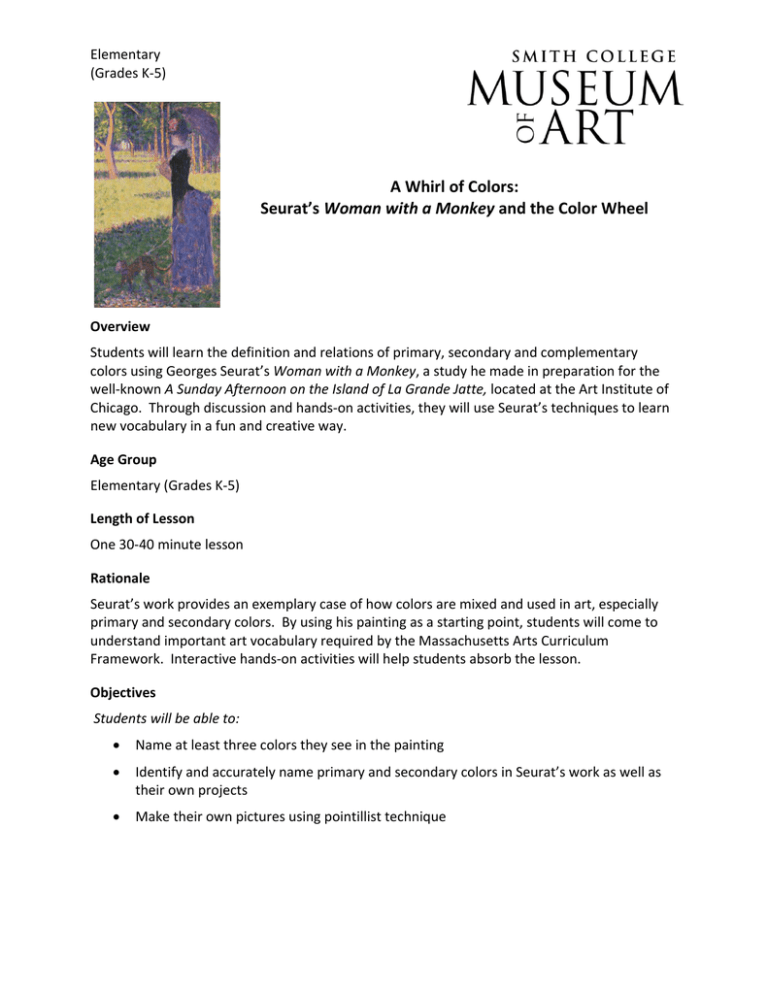
Elementary (Grades K-5) A Whirl of Colors: Seurat’s Woman with a Monkey and the Color Wheel Overview Students will learn the definition and relations of primary, secondary and complementary colors using Georges Seurat’s Woman with a Monkey, a study he made in preparation for the well-known A Sunday Afternoon on the Island of La Grande Jatte, located at the Art Institute of Chicago. Through discussion and hands-on activities, they will use Seurat’s techniques to learn new vocabulary in a fun and creative way. Age Group Elementary (Grades K-5) Length of Lesson One 30-40 minute lesson Rationale Seurat’s work provides an exemplary case of how colors are mixed and used in art, especially primary and secondary colors. By using his painting as a starting point, students will come to understand important art vocabulary required by the Massachusetts Arts Curriculum Framework. Interactive hands-on activities will help students absorb the lesson. Objectives Students will be able to: • Name at least three colors they see in the painting • Identify and accurately name primary and secondary colors in Seurat’s work as well as their own projects • Make their own pictures using pointillist technique Elementary (Grades K-5) Page |2 Massachusetts Curriculum Framework Connection Visual Arts: • Standard I: Methods, Materials, and Techniques 1.3: “Learn and use appropriate vocabulary related to methods, materials, and techniques.” • Standard 2: Elements and Principles of Design 2.1: “Identify primary and secondary colors and gradations of black, white and gray in the environment and artwork.” • Standard 5: Critical Response 5.1: “In the course of making and viewing art, learn ways of discussing it, such as by making a list of all the images [here colors] seen in an artwork.” Materials • Image of Woman with a Monkey and a way to display it to the class (or 1 high-resolution color copy for every 2-3 students) • Image of the final A Sunday Afternoon on the Island of La Grande Jatte • Color wheel with primary and secondary colors • Paper (smaller is better, such as 6x8’’) • Oil pastels in primary and secondary colors, 1 set for every 2-3 students. (Watercolor pencils work OK too.) • Optional: small squares of colored paper, ca. 4x4’’, for holding up. Include black and white. Lesson 1. Warm up: Talk to the students about color. What is their favorite color? Why? What colors do they see around the room or on their clothes? Then talk about what pairings of colors they like. Try starting with combinations on the children’s clothes and then, if you have them, hold up the pieces of colored paper in different combinations. Ask students if they think the colors are the same, similar or totally different. o For slightly older students: Define “contrast” as a group and identify it, starting with the black and white paper and then moving to subtler differences. Use the paper and colors around the room. 2. Display Georges Seurat’s Woman with a Monkey. Ask students what they notice (identify the woman, monkey, trees etc.) What colors do they see? Have each student name one. Then pick a few areas and ask students to look very closely (for example, the ground by the monkey’s feet, the woman’s skirt, or the shadowed grass). What colors do they see? Once they notice the mismatched colors in any one spot, ask: Did they notice that before? Why or why not? What did it take for them to notice? How did the painter use his paintbrush here? Elementary (Grades K-5) Page |3 3. Explain about Seurat’s technique (“pointillism”) of using very small brushstrokes or dots of all kinds of colors and putting them very close together, so that, if you stand back, they blend together. Display the final version of La Grande Jatte. Zoom in and out so students can see the tiny dots vs. the whole picture. 4. Take out the color wheel and explain how it works, defining primary, secondary and complementary colors. Quiz the students a little until they retain the words. Then go back to Seurat’s Woman with a Monkey and identify these colors as a class. 5. Give each student a piece of paper and let them experiment with the oil pastels in primary colors, separately and then mixing. Alternatively, have each student make his or her own color wheel. 6. Hands-on project: Distribute more paper and the rest of the crayons (in the secondary colors). Invite students to make their own ‘pointillist’ picture, using Seurat’s technique of small strokes or dots. It could be a landscape, animal or person. Encourage them to put contrasting colors together, like Seurat did—such as yellow and green for grass. Elementary (Grades K-5) Page |4 About the Art Woman with a Monkey (study for A Sunday Afternoon on the Island of La Grande Jatte) by Georges Seurat. 1884. Oil on canvas. Ca. 10 x 6 in. Purchased with the Tryon Fund, SC 1934:2-1. Smith College Museum of Art. The artist: Georges Seurat Seurat was at the forefront of the self-named Neo-Impressionists. These artists adopted this label to avoid confusion with the original Impressionists like Claude Monet and to pay homage to their predecessors. Other Neo-Impressionists include Paul Signac, Camille Pissarro (who later abandoned Neo-Impressionism), Maxmilien Luce and Henri-Edmond Cross. While they shared the Impressionists’ interest in light and color, they sought to replace the purely perceptual color approach of the Impressionists with the scientific concepts of color theory. Instead of smooth brushstrokes or even the short, dynamic strokes of Impressionists like Monet, they practiced “pointillism:” constructing shapes out of dots—pure color—which the viewer's eye would blend into shades and contours. Seurat was born into a bourgeois family and trained at the prestigious École des Beaux Arts in Paris. When the conservative Salon rejected his work, he allied himself with the “independent” artists of Paris. It was Seurat who developed the concept of pointillism. He wanted to reach beyond Impressionism and apply the results of scientific research to his art, “something new, an art entirely my own.” Although the Impressionists had done similar work with color, Seurat was new in the mathematical strictness with which he juxtaposed complementary colors. Seurat’s ideas, however, were cut short by his early death at age 32. The painting This small panel is a study for Seurat's Sunday Afternoon on the Island of La Grande Jatte, his monumental painting of 6 x 10 feet, now at the Art Institute of Chicago. Seurat made extensive preliminary drawings and oil studies for many of his larger paintings. Sunday Afternoon on the Island of La Grande Jatte is painted in his "pointillist" style, characterized by small dots of pure color. However, the SCMA study, which may have been executed directly on the island, was painted in a looser, more spontaneous manner that resembles classic Impressionism rather than pointillism or “post-Impressionism.” La Grande Jatte is an island on the Seine near Neuilly, a suburb of Paris; during Seurat's time it was a fashionable leisure site for picnicking, walking, and boating, as his large painting reveals. The SCMA study depicts a stylishly-dressed woman with a parasol walking a pet monkey on a leash. Monkeys were not common pets in Seurat's day, and some critics concluded that the monkey, a traditional symbol of lust, indicated that this woman was a prostitute. However, her dress suggests she is a typical middle-class stroller, and the meaning of the monkey remains ambiguous: it could be a commentary on the woman’s pretentiousness or intended to give her a hint of exoticism. In the final painting she is accompanied by a well-dressed man. Page |5 © Smith College Museum of Art Elementary (Grades K-5) Woman with a Monkey (study for A Sunday Afternoon on the Island of La Grande Jatte) by Georges Seurat. 1884. Oil on canvas. Ca. 10 x 6 in. Purchased with the Tryon Fund, SC 1934:2-1. Smith College Museum of Art. This work of art may not be currently on display at the Museum. Page |6 © The Art Institute of Chicago Elementary (Grades K-5) A Sunday Afternoon on the Island of La Grande Jatte by Georges Seurat. 1884-86. Oil on canvas. Ca. 6 x 10 ft. Helen Birch Bartlett Memorial Collection, 1926.224. The Art Institute of Chicago.
